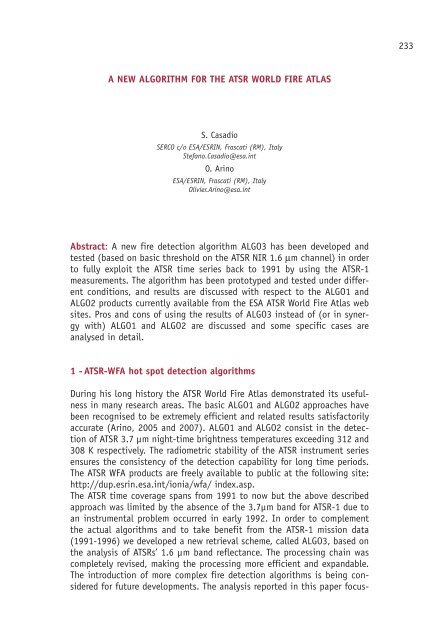7th Workshop on Forest Fire Management - EARSeL, European ...
7th Workshop on Forest Fire Management - EARSeL, European ...
7th Workshop on Forest Fire Management - EARSeL, European ...
Create successful ePaper yourself
Turn your PDF publications into a flip-book with our unique Google optimized e-Paper software.
A NEW ALGORITHM FOR THE ATSR WORLD FIRE ATLAS<br />
S. Casadio<br />
SERCO c/o ESA/ESRIN, Frascati (RM), Italy<br />
Stefano.Casadio@esa.int<br />
O. Arino<br />
ESA/ESRIN, Frascati (RM), Italy<br />
Olivier.Arino@esa.int<br />
Abstract: A new fire detecti<strong>on</strong> algorithm ALGO3 has been developed and<br />
tested (based <strong>on</strong> basic threshold <strong>on</strong> the ATSR NIR 1.6 µm channel) in order<br />
to fully exploit the ATSR time series back to 1991 by using the ATSR-1<br />
measurements. The algorithm has been prototyped and tested under different<br />
c<strong>on</strong>diti<strong>on</strong>s, and results are discussed with respect to the ALGO1 and<br />
ALGO2 products currently available from the ESA ATSR World <strong>Fire</strong> Atlas web<br />
sites. Pros and c<strong>on</strong>s of using the results of ALGO3 instead of (or in synergy<br />
with) ALGO1 and ALGO2 are discussed and some specific cases are<br />
analysed in detail.<br />
1 - ATSR-WFA hot spot detecti<strong>on</strong> algorithms<br />
During his l<strong>on</strong>g history the ATSR World <strong>Fire</strong> Atlas dem<strong>on</strong>strated its usefulness<br />
in many research areas. The basic ALGO1 and ALGO2 approaches have<br />
been recognised to be extremely efficient and related results satisfactorily<br />
accurate (Arino, 2005 and 2007). ALGO1 and ALGO2 c<strong>on</strong>sist in the detecti<strong>on</strong><br />
of ATSR 3.7 µm night-time brightness temperatures exceeding 312 and<br />
308 K respectively. The radiometric stability of the ATSR instrument series<br />
ensures the c<strong>on</strong>sistency of the detecti<strong>on</strong> capability for l<strong>on</strong>g time periods.<br />
The ATSR WFA products are freely available to public at the following site:<br />
http://dup.esrin.esa.int/i<strong>on</strong>ia/wfa/ index.asp.<br />
The ATSR time coverage spans from 1991 to now but the above described<br />
approach was limited by the absence of the 3.7µm band for ATSR-1 due to<br />
an instrumental problem occurred in early 1992. In order to complement<br />
the actual algorithms and to take benefit from the ATSR-1 missi<strong>on</strong> data<br />
(1991-1996) we developed a new retrieval scheme, called ALGO3, based <strong>on</strong><br />
the analysis of ATSRs’ 1.6 µm band reflectance. The processing chain was<br />
completely revised, making the processing more efficient and expandable.<br />
The introducti<strong>on</strong> of more complex fire detecti<strong>on</strong> algorithms is being c<strong>on</strong>sidered<br />
for future developments. The analysis reported in this paper focus-<br />
233
















